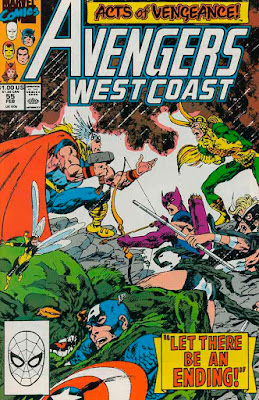Three months after the conclusion of "Acts of Vengeance" came this issue of Web of Spider-Man with "Acts of Vengeance is Back!" on the cover. This issue and the next provide a further epilogue to the series. The story sees the Chameleon arrange the release of several of the villains Spider-Man defeated in the saga and then offers them $500,000 between them to kill Spider-Man.
Web of Spider-Man #64
Writer: Gerry Conway
Penciler: Alex Saviuk
Inker: Keith Williams
Letterer: Rick Parker
Colourist: Bob Sharen
Editor: Jim Salicrup
Editor-in-Chief: Tom DeFalco
It's yet another throwback to the Silver Age where numerous villains sought to defeat Spider-Man in order to cement their position as the leading crime lord in the city. This time the Chameleon isn't bothering with trying to do it personally but has instead made an offer to a group of foes with mixed powers who all want revenge now that Spider-Man no longer has his powers. The villains are a motley group - Titania, Graviton, Goliath, the Brothers Grimm andPaste Pot Pete the Trapster - but they prove sufficiently willing to work together for a mutual goal, given leadership and incentive. It stands in stark contrast to the squabbling committee of the leading super-villains during the crossover.
As Peter Parker, Spider-Man is facing further problems as Nick Katzenberg, the sleazy rival photographer at the Daily Bugle, produces photos showing Peter dressed as Spider-Man for a shoot, leading to editor Joe "Robbie" Robertson sacking him with a rant about journalistic ethics, perhaps because of his own lingering guilt at having failed to report Tombstone in his youth that recently put him in jail. It's often been speculated that Robbie has deduced Spider-Man's identity but keeps it to himself, but his reaction here, even disagreeing with J. Jonah Jameson who is willing to overlook it all as it isn't a news photo, suggests otherwise. Peter storms off and has an angry confrontation with Katzenberg before storming off.
The later battle shows some repeat tricks, with Graviton once again lifting up the Daily Bugle building, but also the need for better leadership in the field as Spidey manages to trick the Brothers Grimm and the Trapster into taking each other out, but Graviton's powers proved rather harder to defeat with strategy.
This is an odd issue. After such a long crossover there wasn't really a crying need for yet more "Acts of Vengeance" issues. These also came out in the run-up to a major story in Amazing Spider-Man entitled "Return of the Sinister Six", reuniting more conventional Spider-Man foes so yet another story involving a group of villains teaming up feels repetitive even if it did manage to come out first. Nor does it present much of a lesson in how teams of villains can work effectively, since Spider-Man is able to play off the limitations and lack of expectations. This is just another demonstration of the problems of having three monthly titles for one character without distinctive purposes, leading to a speedy rehash of recent events.
Web of Spider-Man #64 has been reprinted in:
Web of Spider-Man #64
Writer: Gerry Conway
Penciler: Alex Saviuk
Inker: Keith Williams
Letterer: Rick Parker
Colourist: Bob Sharen
Editor: Jim Salicrup
Editor-in-Chief: Tom DeFalco
It's yet another throwback to the Silver Age where numerous villains sought to defeat Spider-Man in order to cement their position as the leading crime lord in the city. This time the Chameleon isn't bothering with trying to do it personally but has instead made an offer to a group of foes with mixed powers who all want revenge now that Spider-Man no longer has his powers. The villains are a motley group - Titania, Graviton, Goliath, the Brothers Grimm and
As Peter Parker, Spider-Man is facing further problems as Nick Katzenberg, the sleazy rival photographer at the Daily Bugle, produces photos showing Peter dressed as Spider-Man for a shoot, leading to editor Joe "Robbie" Robertson sacking him with a rant about journalistic ethics, perhaps because of his own lingering guilt at having failed to report Tombstone in his youth that recently put him in jail. It's often been speculated that Robbie has deduced Spider-Man's identity but keeps it to himself, but his reaction here, even disagreeing with J. Jonah Jameson who is willing to overlook it all as it isn't a news photo, suggests otherwise. Peter storms off and has an angry confrontation with Katzenberg before storming off.
The later battle shows some repeat tricks, with Graviton once again lifting up the Daily Bugle building, but also the need for better leadership in the field as Spidey manages to trick the Brothers Grimm and the Trapster into taking each other out, but Graviton's powers proved rather harder to defeat with strategy.
This is an odd issue. After such a long crossover there wasn't really a crying need for yet more "Acts of Vengeance" issues. These also came out in the run-up to a major story in Amazing Spider-Man entitled "Return of the Sinister Six", reuniting more conventional Spider-Man foes so yet another story involving a group of villains teaming up feels repetitive even if it did manage to come out first. Nor does it present much of a lesson in how teams of villains can work effectively, since Spider-Man is able to play off the limitations and lack of expectations. This is just another demonstration of the problems of having three monthly titles for one character without distinctive purposes, leading to a speedy rehash of recent events.
Web of Spider-Man #64 has been reprinted in:





























